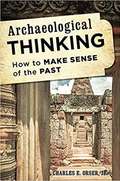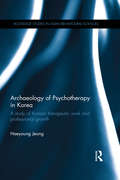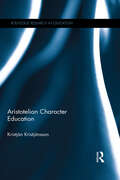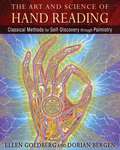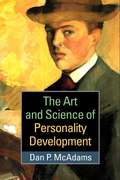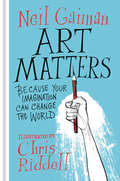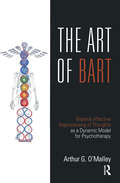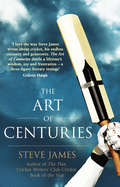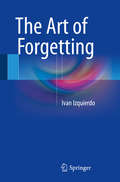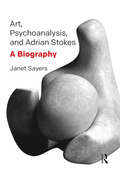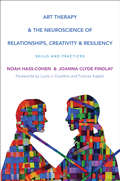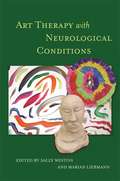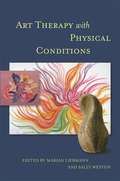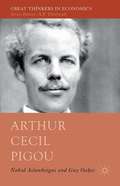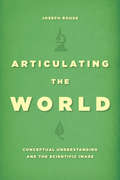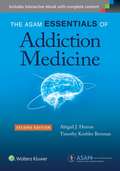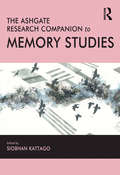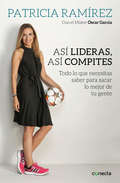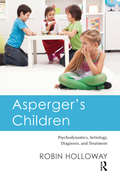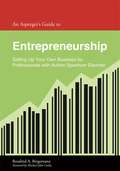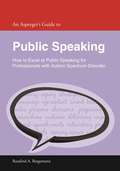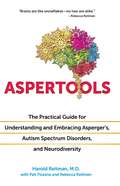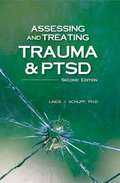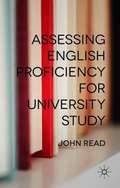- Table View
- List View
Archaeological Thinking: How To Make Sense Of The Past
by Charles E. OrserHow do archaeologists think? How do they use the scattered and often-fragmentary remains from the past—both historical and excavated—to create meaningful, sensible interpretations of human history? In Archaeological Thinking, Charles E. Orser Jr., provides a commonsense guide to applying critical thinking skills to archaeological questions and evidence. Rather than critiquing and debunking specific cases of pseudo-archaeology or concentrating on archaeological theory, Orser considers the basics of scientific thinking, the use of logic and analogy, the meaning and context of facts, and the evaluation of source materials. He explains, concisely and accessibly, how archaeologists use these principles to create pictures of the past and teaches students to develop the skills needed to make equally reasoned interpretations.
Archaeology of Psychotherapy in Korea: A study of Korean therapeutic work and professional growth (Routledge Studies in Asian Behavioural Sciences)
by Haeyoung JeongThis is the first English book dedicated solely to the historical development of psychotherapy in Korea. It is an archaeological research of literature relating to the care and treatment of mind in Korean history in dialogue with spiritual, philosophical, cultural, social, and medical perspectives. It reviews the evolution of different approaches on mental illnesses covering autochthonous practices, psychiatry, clinical psychology, counseling, Western psychotherapy, and Korean psychotherapy. Archaeology of Psychotherapy in Korea inspects: Folk Treatment First Psychiatry Influence from Clinical Psychology Counselling Development Implementation of Western Psychotherapy Shaping of Korean Psychotherapy Its discussion engages firmly with the Korean culture and perspective while acknowledging various extrinsic influences and the fact that Korean psychotherapy continues to evolve in its own unique manner. It aims to refine the understanding of psychotherapy development in Korea in connection with its historical and social backgrounds, and to interpret a way to highlight the culturally relevant psychotherapy that is more suitable as a Korean psychotherapy better attuned to the distinct cultural and societal expectation of Korea.
Aristotelian Character Education (Routledge Research in Education)
by Kristján KristjánssonThis book provides a reconstruction of Aristotelian character education, shedding new light on what moral character really is, and how it can be highlighted, measured, nurtured and taught in current schooling. Arguing that many recent approaches to character education understand character in exclusively amoral, instrumentalist terms, Kristjánsson proposes a coherent, plausible and up-to-date concept, retaining the overall structure of Aristotelian character education.After discussing and debunking popular myths about Aristotelian character education, subsequent chapters focus on the practical ramifications and methodologies of character education. These include measuring virtue and morality, asking whether Aristotelian character education can salvage the effects of bad upbringing, and considering implications for teacher training and classroom practice. The book rejuvenates time-honoured principles of the development of virtues in young people, at a time when ‘character’ features prominently in educational agendas and parental concerns over school education systems.Offering an interdisciplinary perspective which draws from the disciplines of education, psychology, philosophy and sociology, this book will appeal to researchers, academics and students wanting a greater insight into character education.
The Art and Science of Hand Reading: Classical Methods for Self-Discovery through Palmistry
by Dorian Bergen Ellen GoldbergA comprehensive guide to the inner psychology revealed by the hand • Details how to interpret the entire hand--the shape of the palm and fingers, mounts, lines, fingerprints, flexibility, nails, and skin texture • Reveals the personality archetypes, strengths, and weaknesses connected with each of the seven mounts and how the rest of the hand modifies these traits • Explains how lines change and the decisive influence of the person’s own mind in healing defects found on the lines Palmistry is a science and a universal language. The hand tells a story about your talents, relationships, health, and how you feel about yourself. It reveals periods of ease or challenge in your life, and it speaks about your weaknesses and the traits you need to develop. As you change, so do your hands, reflecting the progress you have made. In this comprehensive guide to hand reading, based on Ellen Goldberg’s 40 years of teaching palmistry and the Western Mystery tradition, the authors make the powerful insights of the hand accessible in an inviting and user-friendly manner. The book presents the character traits and personality archetypes associated with each of the seven mounts of the palm and shows how to determine which are most influential in the nature of the individual. The mount archetypes reveal the lifestyle, love,sex, and marriage preferences; the best career choices; and the unique strengths and weaknesses for each person. The book also examines other factors that enhance the qualities revealed by the mount types, including the flexibility of the hand, texture of the skin, and the shapes of the fingers, fingertips, and nails. The meaning of each major and minor line is described in detail as well as the influence the person’s own mind has in healing defects and obstacles found on their lines. The authors also provide accurate timing guides for each line, making it possible to locate specific events and to see how your lines change over time. Presenting the hand as a guide to self-fulfillment, The Art and Science of Hand Reading incorporates correspondences to other mystical sciences such as astrology, Kabbalah, the Hermetic teachings, and archetypal psychology. It also includes practical examples and more than 600 illustrations to show how to integrate the meanings of each part of the hand to form a complete picture of your inner psychology and your ever-changing destiny.
The Art and Science of Personality Development
by Dan P. McadamsDrawing on state-of-the-art personality and developmental research, this book presents a new and broadly integrative theory of how people come to be who they are over the life course. Preeminent researcher Dan P. McAdams traces the development of three distinct layers of personality--the social actor who expresses emotional and behavioral traits, the motivated agent who pursues goals and values, and the autobiographical author who constructs a personal story for life. Highly readable and accessible to scholars and students at all levels, the book uses rich portraits of the lives of famous people to illustrate theoretical concepts and empirical findings.
Art and Vision in the Inca Empire
by Adam HerringIn 1500 CE, the Inca empire covered most of South America's Andean region. The empire's leaders first met Europeans on November 15, 1532, when a large Inca army confronted Francisco Pizarro's band of adventurers in the highland Andean valley of Cajamarca, Peru. At few other times in its history would the Inca royal leadership so aggressively showcase its moral authority and political power. Glittering and truculent, what Europeans witnessed at Inca Cajamarca compels revised understandings of pre-contact Inca visual art, spatial practice, and bodily expression. This book takes a fresh look at the encounter at Cajamarca, using the episode to offer a new, art-historical interpretation of pre-contact Inca culture and power. Adam Herring's study offers close readings of Inca and Andean art in a variety of media: architecture and landscape, geoglyphs, sculpture, textiles, ceramics, featherwork and metalwork. The volume is richly illustrated with over sixty color images.
Art Matters: Because Your Imagination Can Change the World (Apple FF)
by Neil Gaiman Chris RiddellA stunning and timely creative call-to-arms combining four extraordinary written pieces by Neil Gaiman illustrated with the striking four-color artwork of Chris Riddell.“The world always seems brighter when you’ve just made something that wasn’t there before.”—Neil GaimanDrawn from Gaiman’s trove of published speeches, poems, and creative manifestos, Art Matters is an embodiment of this remarkable multi-media artist’s vision—an exploration of how reading, imagining, and creating can transform the world and our lives.Art Matters bring together four of Gaiman’s most beloved writings on creativity and artistry: “Credo,” his remarkably concise and relevant manifesto on free expression, first delivered in the wake of the Charlie Hebdo shootings“Make Good Art,” his famous 2012 commencement address delivered at the Philadelphia University of the Arts“Making a Chair,” a poem about the joys of creating something, even when words won’t come“On Libraries,” an impassioned argument for libraries that illuminates their importance to our future and celebrates how they foster readers and daydreamersFeaturing original illustrations by Gaiman’s longtime illustrator, Chris Riddell, Art Matters is a stirring testament to the freedom of ideas that inspires us to make art in the face of adversity, and dares us to choose to be bold.
The Art of BART: Bilateral Affective Reprocessing of Thoughts as a Dynamic Model for Psychotherapy
by Arthur G. O'MalleyThe Art of BART (the Bilateral Affective Reprocessing of Thoughts) is a practitioner's introduction to an innovative psychotherapy model that draws on and integrates well-proven therapies (such as EMDR, sensorimotor psychotherapy and CBT) and on the Indian chakra tradition and other historical beliefs. As a therapeutic approach it has particular relevance to those who are living with the consequences of a traumatic event and those who seek after peak performance in fields such as sport and the arts. The book introduces the reader to BART as a psychotherapy that can benefit patients with disorders such as anorexia nervosa and dissociative identity disorder, and those who have suffered a traumatic event. It also looks at the information processing of the mind-body at the levels of the gut heart and the gut brain, and it makes connections between the endocrine and immune systems and the chakras of Indian tradition.
The Art of Centuries
by Steve JamesA century has always had a special resonance, in all walks of life, and none more so than in cricket. Scoring one hundred runs is the ultimate for a batsman. As former England captain Andrew Strauss admits, it's incredibly hard to do; for Ricky Ponting, it's a transformational moment in the career of a cricketer. Or in the words of Geoffrey Boycott, 'a century has its own magic'.In The Art of Centuries, Steve James applies his award-winning forensic insight to the very heart of batting. Through interviews with the leading run-scorers in cricket history and his own experiences, Steve discovers what mental and physical efforts are required to reach those magical three figures. Despite his own haul of 47 first-class tons, he himself felt at times that he was poorly equipped for the task.So working out how to score centuries is an art. And bowlers might not agree, but there really is no better feeling in cricket.
The Art of Forgetting
by Ivan IzquierdoHow do we forget? Why do we need to forget? This book intends to answer to these and other questions. It aims to demonstrate that each one is who it is due to their own memories. Thus, distinguish between the information we should keep from those we should forget is an difficult art. In this book, the author discusses about the different types of memory, the main types of forgetting (avoidance, extinction and repression), their brain areas and their mechanisms. In this sense, the art of forgetting, or the art of do not saturate our memory mechanisms, is something innate, that benefits us anonymously, keeping us from sinking amidst our own memories. The essays that compose this book go through several aspects, since individuals to societies' memory. By the end of the book, the reader will be able to understand that we forget to be able to think, to live and to survive.
Art, Psychoanalysis, and Adrian Stokes: A Biography
by Janet SayersIllustrated with Barbara Hepworth's abstract stone carving, with other works of art, and with fascinating vignettes from Adrian Stokes's writing, this biography highlights his revolutionary emphasis on the materials-led inspiration of architecture, sculpture, painting, and the avant-garde creations of the Ballets Russes. In also detailing Stokes's role as catalyst of the transformation of St Ives in Cornwall into an internationally-acclaimed centre of modern art, and his falling in love again in his early forties, this biography shows how Stokes used all these experiences, together with his many years of psychoanalytic treatment by Melanie Klein, in forging insights about ways the outer world gives form to the inner world of fantasy and imagination.
Art Therapy and the Neuroscience of Relationships, Creativity, and Resiliency: Skills and Practices
by Louis Cozolino Noah Hass-Cohen Joanna Clyde Findlay Frances KaplanPresenting a neuroscientifically aware approach to art therapy. Art Therapy and the Neuroscience of Relationships, Creativity, and Resiliency offers a comprehensive integration of art therapy and interpersonal neurobiology. It showcases the Art Therapy Relational Neuroscience (ATR-N) theoretical and clinical approach, and demonstrates how it can be used to help clients with autobiographical memory, reflecting and creating, touch and space, meaning-making, emotions, and dealing with long-term stress and trauma. The ATR-N approach, first developed by Noah Hass-Cohen, is comprised of six principles: Creative Embodiment, Relational Resonating, Expressive Communicating, Adaptive Responding, Transformative Integrating, and Empathizing and Compassion (CREATE). The chapters in this book are organized around these CREATE principles, demonstrating the dynamic interplay of brain and bodily systems during art therapy. Each chapter begins with an overview of one CREATE principle, which is then richly illustrated with therapeutic artwork and intrapersonal reflections. The subsequent discussion of the related relational neuroscience elucidates how the ATR-N work is grounded in research and evidence-based theory. The last section of each chapter, which is devoted to clinical skills and applications, integrates practices and approaches across all six of the CREATE principles, demonstrating how therapeutic art making can help people decipher the functional mystery of their relational nervous system, enhance their emotive and cognitive abilities, and increase the motivation to learn novel concepts and participate in a meaningful social discourse.
Art Therapy with Neurological Conditions
by Jackie Ashley Quentin Bruckland Elizabeth Ashby Anna Knight Christopher Day Judith Ducker Iris Von Hyde Marian Liebmann Mark Wheeler Sally Weston Marion Green Debbie Michaels Melody Golebiowski Andrea Gregg Simon Bell Carole Connelly Jenny WoodBy creating a therapeutic outlet for self-expression and processing trauma, art therapy can play a powerful role in assisting people with a brain injury or neurological condition to adjust to living with altered abilities and ways of thinking. Bringing together a wealth of expertise from specialists working with a range of conditions including epilepsy, dementia, acquired brain injury, motor neurone disease and multiple sclerosis, this book describes both the effects of the conditions and the ways in which art therapy has helped in the rehabilitation process. The book includes work with groups and individuals and with a wide range of settings and age groups, from children to older adults, and discusses the implications of research from neuroscience and neuropsychology. This will be essential reading for art therapists and students working with neurological conditions. Other professionals working with people with neurological conditions such as psychotherapists and counsellors, doctors, nurses and complementary therapists will also find it of interest.
Art Therapy with Physical Conditions
by Michael Fischer Karen Huckvale Michele Wood Dr Trevor Thompson Julie Jackson Malcolm Learmonth Jo Bissonnet Jo Beedell Sarah Lewis Carole Simpson Cherry Lawrence Marian Liebmann Nicki Power Sally Weston Don Ratcliffe Simon Richardson Alison Hawtin Kayleigh Orr Jo CliftonAs the emotional components of physical illnesses become more recognised, there is a renewed interest in the potential of art therapy to help patients come to terms with injury, pain and terminal and life-long conditions. A wide range of experienced art therapists describe their work and its benefits to a variety of groups including those with cancer, debilitating conditions such as myalgic encephalopathy (M.E.) and ulcerative colitis. Physical conditions in combination with other factors such as homelessness or learning disabilities, and children with life-long and chronic conditions are also covered. The book includes discussion of spiritual and philosophical issues when mortality is faced, life change and adjustment issues, practical considerations and which models of practice art therapists find most helpful with various groups. This will be essential reading for arts therapists and students, as well as for professionals with an interest in psychological issues and wellbeing for patients with physical illness or long term conditions, such as psychotherapists and counsellors, complementary therapists, doctors, nurses and other healthcare professionals.
Arthur Cecil Pigou (Great Thinkers In Economics Ser.)
by Guy Oakes Nahid AslanbeiguiThe British economist Arthur Cecil Pigou (1877-59) reconceptualized economics as a theory of economic welfare and a logic of policy analysis. Misconceptions of his work abound. This book, an essay in demystification and the first reading of the entire Pigouvian oeuvre, stresses his pragmatic and historicist premises.
Articulating the World: Conceptual Understanding and the Scientific Image
by Joseph RouseNaturalism as a guiding philosophy for modern science both disavows any appeal to the supernatural or anything else transcendent to nature, and repudiates any philosophical or religious authority over the workings and conclusions of the sciences. A longstanding paradox within naturalism, however, has been the status of scientific knowledge itself, which seems, at first glance, to be something that transcends and is therefore impossible to conceptualize within scientific naturalism itself. In Articulating the World, Joseph Rouse argues that the most pressing challenge for advocates of naturalism today is precisely this: to understand how to make sense of a scientific conception of nature as itself part of nature, scientifically understood. Drawing upon recent developments in evolutionary biology and the philosophy of science, Rouse defends naturalism in response to this challenge by revising both how we understand our scientific conception of the world and how we situate ourselves within it.
The ASAM Essentials Of Addiction Medicine
by Abigail J. Herron Timothy Koehler BrennanA masterful, high-yield guide to the treatment of substance abuse issues, The ASAM Essentials of Addiction Medicine equips you with the expert know-how you need to provide effective help for your patients. Derived from The ASAM Principles of Addiction Medicine, 5th Edition - widely hailed as the definitive comprehensive clinical reference in the field - this companion resource presents the collective wisdom of hundreds of esteemed authorities on the art and science of addition medicine. Yet, it does so in a succinct format that will appeal to specialists seeking a more streamlined, quick-access reference source. -Find the authoritative answers you need on everything from the pharmacology of addiction through diagnosis, assessment, and early intervention; various forms of addiction management. . . treatment of individual patient populations; management of intoxication and withdrawal; pharmacologic and behavioral interventions; recovery programs; medical disorders and complications. . . co-occurring addiction and psychiatric disorders; pain and addiction; children and adolescents; and ethical, legal, and liability issues. -Contribute to public health in the area of addiction thanks to a special introductory chapter entitled A Public Health Approach to Prevention: The Health Professional,,s Role. -Easily switch back and forth between the ASAM Essentials and the parent text thanks to a parallel chapter organization. -Zero in on the most important, practical information thanks to highly focused, efficient coverage. -Maximize your understanding and retention of vital concepts with the aid of key points summaries, review questions, and suggested readings in each chapter.
The Ashgate Research Companion to Memory Studies
by Siobhan KattagoMemory has long been a subject of fascination for poets, artists, philosophers and historians. This timely volume, edited by Siobhan Kattago, examines how past events are remembered, contested, forgotten, learned from and shared with others. Each author in The Ashgate Research Companion to Memory Studies has been asked to reflect on his or her research companions as a scholar, who studies memory. The original studies presented in the volume are written by leading experts, who emphasize both the continuity of heritage and tradition, as well as the memory of hostilities, traumas and painful events. Comprised of four thematic sections, The Ashgate Research Companion to Memory Studies provides a comprehensive overview of the latest research within the discipline. The principal themes include: ¢ Memory, History and Time ¢ Social, Psychological and Cultural Frameworks of Memory ¢ Acts and Places of Memory ¢ Politics of Memory, Forgetting and Democracy Featuring contributions from key thinkers in the field, this comprehensive volume will be a valuable resource for all academics and students working within this area of study.
Así lideras, así compites: Todo lo que necesitas saber para sacar lo mejor de tu gente
by Óscar García Junyent Patricia Ramírez LoefflerCómo liderar equipos, sean de fútbol, de trabajo o tu propia familia. «El talento gana juegos, pero el trabajo en equipo y la inteligencia ganan campeonatos» Michael Jordan Si como afirma Jorge Valdano el fútbol es un laboratorio de la vida, la figura del entrenador resulta ideal como punto de partida para comprender las verdaderas claves de la dirección de equipos y de la gestión de personas. Partiendo de esta premisa, Patricia Ramírez explica en Así lideras, así compites las herramientas que permitirán al lector mejorar sus capacidades cuando se ponga al frente de un grupo de personas, sean estas un departamento de una empresa, un equipo deportivo, los estudiantes de una clase o su propia familia. A partir de su propia experiencia con equipos de fútbol de primer nivel y con deportistas de élite, Patricia ha sido capaz de condensar las características que hacen de una persona un buen entrenador: desde la habilidad para marcar objetivos claros, hasta la capacidad para soportar la presión, pasando por la predisposición para delegar bien. En definitiva, la importancia de contar con un equipo motivado para alcanzar el éxito y las claves para conseguirlo. Porque en última instancia, más que los resultados, lo que cuenta para el éxito a largo plazo es el rendimiento. Reseñas: «Así lideras, así compites es una gran guía sobre el liderazgo aplicado al deporte, especialmente al fútbol. Además de dar a conocer distintas herramientas y fórmulas para liderar tanto en el ámbito deportivo como para aplicarlo a la propia vida, cada capítulo se cierra con la visión de Óscar García y sus experiencias en el banquillo. Me parece una propuesta diferente y fresca.» Vicente del Bosque, seleccionador nacional «El libro Así lideras, así compites transmite valores de esfuerzo, liderazgo y equipo que comparten el mundo del fútbol y de la empresa, valores imprescindibles para buscar el éxito personal y profesional, y así poder disfrutar de la satisfacción del trabajo bien hecho.» Javier Jiménez, empresario y vicepresidente del Granada CF «Claridad, perspectiva, inteligencia, equilibrio, audacia, lealtad, confianza, credibilidad, buen humor, compromiso... El poder de las expectativas y del ejemplo, la fuerza del grupo... Así lideras, así compites describe de forma práctica y sencilla, ejercicios incluidos, las características de un buen entrenador, un líder, y el camino para acercarse lo más posible a la meta. Una lección de vida.» Óscar Campillo, director del diario Marca «En el deporte profesional es necesario querer poder, pero sobre todo creer. Visualizar el éxito antes de conseguirlo y concienciarse de cada paso que hay que dar en su búsqueda. Y por eso la figura del psicólogo deportivo es tan imprescindible como la del entrenador o el preparador físico. Patricia Ramírez y este libro son buena prueba de ello, y deportistas como Rafa Nadal demuestran a diario que la mente puede vencer a la materia.» Manolo Lama, periodista de la cadena Cope y Deportes Cuatro
Asperger's Children: Psychodynamics, Aetiology, Diagnosis, and Treatment
by Robin HollowayThe DSM-5 (2013) classifies all autism-related disorders, including Asperger's, under the heading "autism spectrum disorder." This book argues that this lumping together is unhelpful for clinicians. Instead, finer diagnostic distinctions are helpful to clinicians who treat children with Asperger's. This book spells out in detail the psychodynamics the author has repeatedly uncovered in Asperger's children, adolescents, and adults, and explores the central factors in the aetiology of Asperger's Disorder. There is a section suggesting how Asperger's can be adequately diagnosed from "the outside" (using external descriptive features) and more importantly from "the inside" (based on internal psychodynamic processes). Finally, there is a section outlining psychodynamic treatment approaches to Asperger's children, based on their psychodynamics and on which type of Asperger's is present. The book includes numerous case illustrations to help the reader appreciate the central psychodynamics that are regularly observed in Asperger's children, namely splitting of the self into victim and bully aspects, and projective identification into remote objects.
An Asperger's Guide to Entrepreneurship: Setting Up Your Own Business for Professionals with Autism Spectrum Disorder
by Michael John Carley Rosalind BergemannEntrepreneurship can be an ideal career option for enterprising individuals with Asperger Syndrome (Autism Spectrum Disorder) and this detailed guide explains how to tell if being self-employed is right for you and how to go about starting and growing your own business. Written by a successful entrepreneur and business consultant with Asperger Syndrome, this book provides all the guidance you need on the practicalities of starting up a company. The unique strengths that people with Asperger Syndrome can bring to a new business venture are highlighted and solutions are offered for elements of entrepreneurship that can create stumbling blocks such as developing working relationships within your company, marketing yourself and your business, managing finances, networking and maintaining a healthy work-life balance. Full of pragmatic advice, case studies from established business owners with Asperger Syndrome and practical tools for professional development, this is an essential startup handbook for anyone on the spectrum considering making the leap to becoming an entrepreneur.
An Asperger's Guide to Public Speaking: How to Excel at Public Speaking for Professionals with Autism Spectrum Disorder
by Rosalind A. BergemannThis practical guide to effective public speaking for professionals with Asperger Syndrome (Autism Spectrum Disorder) provides tailored advice on using your Asperger strengths to your advantage and overcoming areas of challenge to find your public speaking voice. Written by a business leader with Asperger Syndrome, it includes guidance and hands-on tools for preparation, research and delivery of successful speeches and presentations. It addresses all the key areas that can cause particular difficulty for people with Asperger Syndrome such as coping with anxiety, interpreting the facial expressions of your audience, awareness of your own body language as projected to others, sensory overload issues caused by the speaking environment, and surviving post-speech networking and social events. Whether giving a presentation at a meeting, hosting a corporate event, or delivering an autism awareness speech, this book provides all the guidance that professionals with Asperger Syndrome need to master public speaking.
Aspertools: The Practical Guide for Understanding and Embracing Asperger's, Autism Spectrum Disorders, and Neurodiversity
by Dr. Harold ReitmanIf you ask Dr. Harold Reitman, labels are a lousy way to describe a unique human being, whether it's Asperger's, high functioning autism, ADHD, dyslexia, Tourette's or even the so-called neurotypical brain itself. One size does not fit all. Everyone's brain is different. Helping others 'get it' when it comes to dealing with those with so-called learning disabilities is why Reitman has written this book. It's also why he wrote and produced The Square Root of 2, a movie about a college student who encounters—and fights—her school's unjust system. The film was inspired by the real events faced by his daughter and contributing author, Rebecca, when she went to college; her seizure disorder and—at the time—undiagnosed Asperger syndrome posed unique challenges not faced by most students. After reviewing the scientific community's research, conducted over the last nearly 40 years, Dr. Reitman believes that it's time to not just accept neurodiversity, but to embrace it, and this book will help people do just that. It is the first book to offer simple tools, action plans and resources to help understand and deal with anyone whose brain is a bit different. The astonishing rate of autism births alone (1 in 68) means that society will have to adapt to neurodiversity, just as it has had to adapt to other cultural and racial differences. Our educational system, our workplaces, and society at large will no longer be one size fits all—each individual will have the opportunity to maximize their potential—and we will be the better for it.
Assessing and Treating Trauma and PTSD (Second Edition)
by Linda J. SchuppAssessing and Treating Trauma and PTSD, 2nd Edition, masterfully explores the nature of traumatic stress and provides spot-on assessment tools for various trauma-related criteria. The second edition updates include all trauma-related DSM-5 diagnoses, as well as new theories, research and therapeutic techniques. This collection of physiological and psychological techniques provides professions with a practical, eclectic approach to a variety of treatments. * "High-Risk" Indicators for PTSD * Changes from DSM-IV-TR to DSM-5 * DSM-5 Predictors for PTSD * Dissociation and Treatments * Attachment Theory and Neurobiology of Broken Attachment Bonds * Nutritional Supplement Update for the Prevention and Treatment of PTSD * Current Psychopharmacological Studies for PTSD * The Relationship as Therapy * Complex Posttraumatic Stress Disorder Criteria and Treatment
Assessing English Proficiency for University Study
by John ReadThis book focuses on strategies and procedures for assessing the academic language ability of students entering an English-medium university, so that those with significant needs can have access to opportunities to enhance their language skills.
